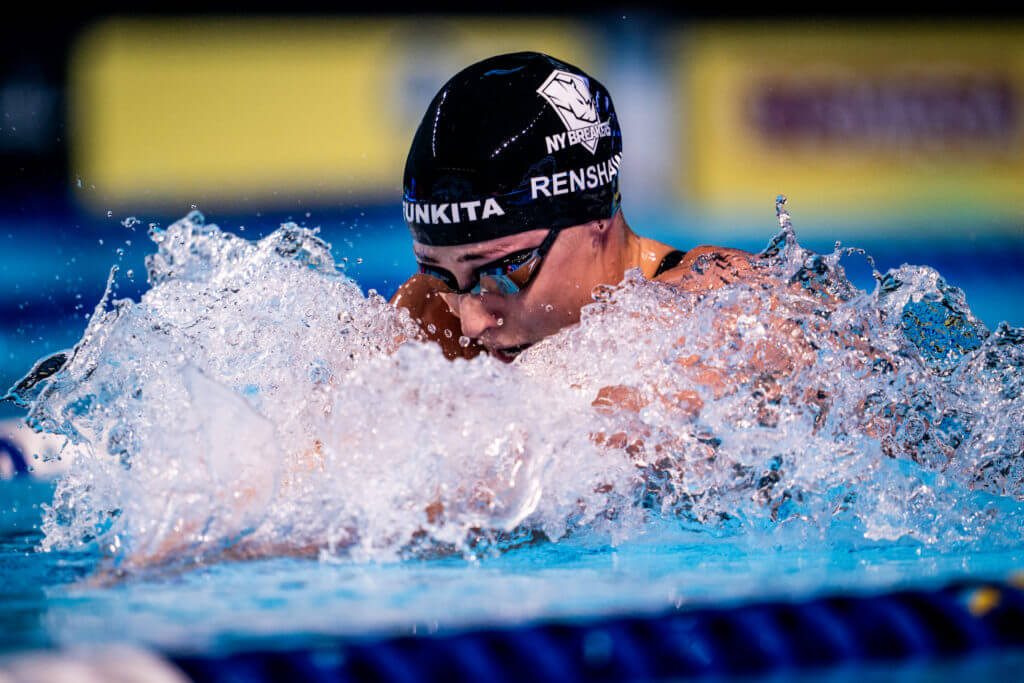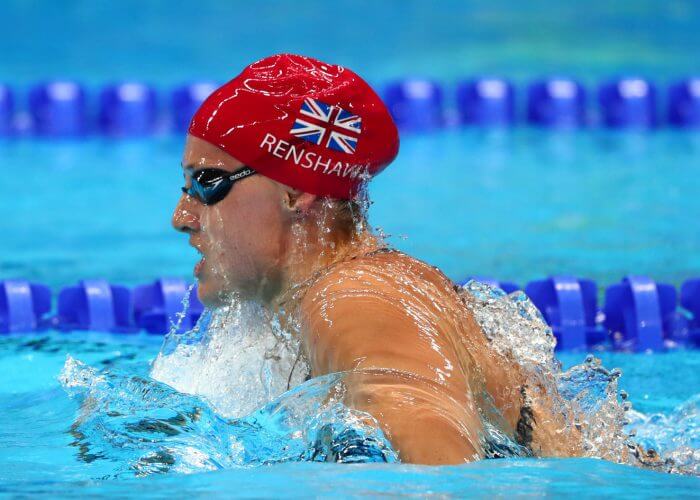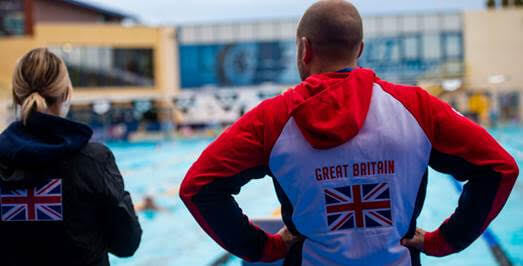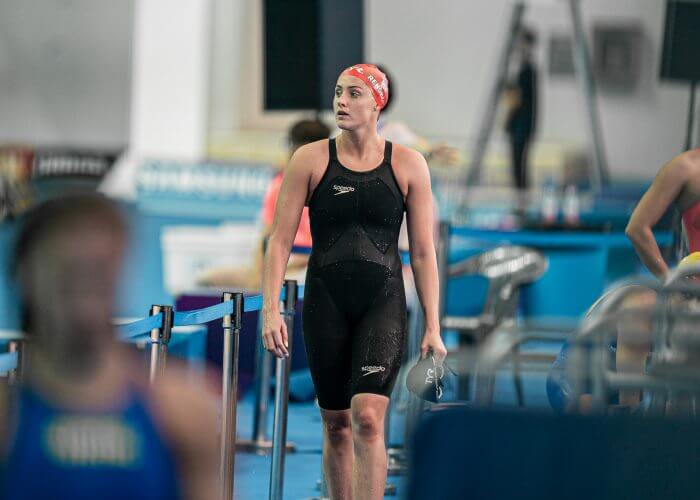Molly Renshaw Talks Manchester, Dave Hemmings And Her Personal ISL Legacy

Molly Renshaw hesitated for a second or two when asked about matching the British 200m breaststroke record at last month’s Manchester International Swim Meet.
The three-time European medallist went 2:22.08 to equal the national mark set by Jocelyn Ulyett at the British Championships in April 2017.
It was a time that would have been good enough for bronze at Rio 2016 – in which Renshaw was sixth – and silver at the 2019 World Championships, where she finished fifth.
Her performance propelled Renshaw top of the fledgling world rankings ahead of Loughborough training mate Abbie Wood who clocked a huge PB in 2:22.77 with the pair the only women to go sub-2:23 so far this year.
It was a continuation of the times she was producing in training but one that was done under race conditions and her progression from 2:24 heat to final added further confidence with Tokyo just four months hence.
Renshaw – who also took 100br gold and 50 bronze – told Swimming World:
“I don’t want to word it badly but I guess I wasn’t all that surprised.
“We’ve been doing a lot of stand-ups in training and race simulations because we didn’t know what racing opportunities we’d get.
“Training has been going really well and I’ve been swimming faster than I ever have in pace sessions and even in December we did some stand-ups and I went a 1:06 and a 2:22 then.
“So that was a confidence builder and I knew I had that kind of swim in me – it was just nice to get it officially on paper and do it under racing conditions.
“It’s obviously been a really weird year but it’s given me chance to focus on things that I wasn’t perfecting last year.”

Molly Renshaw; Photo Courtesy: Rob Schumacher-USA TODAY Sports
Dave Hemmings And ISL Legacy
Renshaw trains at the National Centre Loughborough under the watchful eye of coach Dave Hemmings in a group including Wood, Max and Joe Litchfield and James Wilby.
Hemmings is active on social media posting content of his swimmers’ skills, drills and exercises as well as coaching tips and athlete plans.
The improvements in many of his training group are stark and fellow coach Sean Balmer – who guided Tokyo-bound Luke Greenbank to world and European junior success at Cockermouth – singled Hemmings out for his leadership.
Renshaw concurred, saying:
“If I had to describe him in one word it would be technical.
“I think that’s where a lot of us have improved.
“We’ve tweaked all our technique and things we’ve always need to work on: this past year has given us that opportunity to build our fitness throughout last year and we’ve had the chance to work on our technique and now it’s about getting fast again.
“So (being) given that little bit of extra time for everyone in our group it’s been a bit of a blessing: Abbie and Joe are swimming faster than they ever have, I’m training better than I ever have and James Wilby is.
“At the minute the group is on such a high and it makes it so much easier coming into training. Everyone is constantly riding that wave that it just helps keep momentum within the group.”
She added:
“Dave is constantly planning ahead and every time pretty much we get our own individual sessions.
“This morning even though me and James Wilby swim the same events we still had two individual sessions and there are about six sessions going on across the pool from sprinters like James up to 10k swimmers like Jack Burnell.
“He’s so flexible with everything: there can be so many sessions going on and with the help of assistant coaches we manage to make it work.
“It is a little bit hectic looking from the outside but it works.”

Mel Marshall & Dave Hemmings: Photo Courtesy: British Swimming
With Hemmings, everything is tailored to the individual involving hours of planning and commitment to each swimmer.
Renshaw continued:
“We try and meet at the start and end of every block so he’ll plan three or four weeks in advance and talk you through it.
“After Manchester we had a recovery week and then this week we’re doing a simulation week where we’re racing because this week we should have been at the McCullagh International.
“Next week we are back into heavy, intense race-pace work before we do simulation the week after.
“Every week we get sent a plan out and it’s completely individual to you and sometimes we slot in with each other and sometimes it’s like you need to do this tonight, and these need to do this tonight.”
The three-time Commonwealth medallist was nervous ahead of the Manchester meet as it was 11 months since she had done a long-course race.
However, she was on the New York Breakers team that competed at the ISL for six weeks in October/November in Budapest.
The 24-year-old loved the team environment and the notion of earning points for the whole group that was headed by Tina Andrew who Renshaw describes as “one of the coolest women I know”.
Caeleb Dressel told Swimming World that during ISL he had learned to race based on feel rather than count his kicks and strokes.
The six-week bubble in Budapest allowed swimmers to learn new lessons whether that be from fellow competitors with whom they lived and trained, coaches or from their own observations and experiences.
Renshaw has benefited physically and mentally from the competition in terms of racing and of erasing a psychological block with the 200br.

Molly Renshaw: Photo Courtesy: M. Shaw
She said:
“I said to my coach the first weekend that we raced that I feel like an age-grouper again.
“I’m not used to getting out of the 200 breaststroke, having 20 minutes and then doing a 200IM and then the next day 100 breaststroke and 100 IM. That’s just not what we do!
“You race two days, then two days off, then racing again for two days. It is so tiring on your body but I think because you’re doing it for a team and you’re constantly being uplifted by everybody it makes it so much easier.
“I think it’s great race conditioning because my coach was worried about us being away for six weeks and not having that consistent training but I think it did us all so much good.
“Having so much racing in such a short amount of time we almost all came back in the best shapes of our lives.”
She added:
“I think having to do so many 200 breaststrokes in such a short amount of time it’s built my confidence so much that I know I can get in the pool and I can deliver a good 200br whether I’m rested or not now.
“I think the seasons before I would almost dread the 200 breaststroke – I’d be like it’s such a long way and something I’d do not that often.
“Now since we’ve been back from the ISL I’ve built my confidence at it.
“We’ve kept the 200 in training with the simulations – I have confidence going into a 200 breaststroke knowing that I can do this, it’s so much easier to me than it has been in any other year.
“I think mentally having that block lifted over a 200br has really helped.”
Advertising: Shop At Swim360



